Shear Behavior of Stud-PBL Composite Shear Connector for Steel–Ceramsite Concrete Composite Structure
Abstract
:1. Introduction
2. Push-Out Experiment
2.1. Experimental Design
2.2. Experimental Phenomena
2.3. Experimental Results
3. Push-Out Experimental Finite Element Numerical Simulation
3.1. Overview of the Finite Element Model
- (1)
- Material constitutive model
- (2)
- Element type and mesh division
- (3)
- Interaction and boundary conditions
3.2. Analysis of Finite Element Results
4. Finite Element Parameters Analysis
4.1. Parameters Design of Orthogonal Test Analysis Model
4.2. Analysis of the Orthogonal Test Simulation Results
4.3. Analysis of the Influencing Factors on the Shear Bearing Capacity of Composite Shear Connectors
- (1)
- Influence of the strength of the concrete
- (2)
- Influence of the diameter of the stud
- (3)
- Influence of the thickness of the perforated plate
- (4)
- Influence of the diameter of the opening
- (5)
- Influence of the diameter of the penetrating steel bar
5. Calculation Formula for Shear Resistance
6. Conclusions
- (1)
- The push-out test on one stud shear connector (LT-S), one PBL shear connector (LT-P), and three stud–PBL composite shear connectors (LT-C) reveals the superior shear resistance of the composite shear connector. In addition, composite shear connectors have excellent plastic deformation properties.
- (2)
- The finite element software Abaqus was used to simulate the push-out test with five specimens. The analysis results were in agreement with the experimental phenomenon, load–slip curve, and shear bearing capacity of the push-out test. In addition, the illustrations of stress and concrete damage can reveal the shear damage mechanism and failure form of the shear connector. It is feasible to use finite element simulation to reveal the force mechanism of the composite shear connector and perform parametric analysis.
- (3)
- According to the results of the orthogonal test simulation analysis, increases in the stud diameter, perforated plate thickness, and concrete strength can improve the shear bearing capacity of the composite shear connector, among which the concrete strength has the most obvious effect. However, an increase in the diameter of the penetrating steel bar exerts no apparent effects on shear capacity. Regarding the opening diameter, the shear bearing capacity increases first and then decreases with its increase. When the diameter of the opening was nearly 40 mm, the shear bearing capacity was more favorable. The optimal construction combination for the composite shear connector is the stud with 19 mm diameter, the opening with 50 mm diameter, the perforated plate with 24 mm thickness, and the penetrating steel with 16 mm diameter. Moreover, when the concrete strength was constant in the actual project, it was the key to controlling the thickness of the perforated plate, considering the structure of the composite shear connector.
- (4)
- By conducting multivariate linear regression analysis on the results of the finite element parameter analysis, the calculation formula of the shear bearing capacity of the composite shear connector was obtained. The calculated value is about 85% of the measured value, which displays a good correlation and verifies the feasibility of the calculation formula. The calculation results are conservative, and a formula can be used to calculate the shear bearing capacity of the composite shear connector in practical engineering with the safety factor considered.
- (5)
- The experimental results, numerical simulation outcomes, and calculation formulas have a certain promoting effect on further reducing the self-weight of the composite structure and improving the shear resistance of the composite structure interface. However, the number of push-out test specimens is relatively small. In subsequent studies, experiments will be performed to further discuss the shear resistance of the stud–PBL composite shear connector and the method for calculating the shear bearing capacity.
Author Contributions
Funding
Institutional Review Board Statement
Informed Consent Statement
Data Availability Statement
Conflicts of Interest
References
- Liang, F.; Zhou, Z.X. New Shear Connectors Based on PBL Shear Connector for Composite Arch Members. Struct. Eng. Int. 2014, 2, 281–284. [Google Scholar]
- Wu, F.; Liu, S.; Xue, C.; Yang, K.; Feng, Y.; Zhang, H. Experimental Study on the Mechanical Properties of Perfobond Rib Shear Connectors with Steel Fiber High Strength Concrete. Materials 2021, 14, 3345. [Google Scholar] [CrossRef] [PubMed]
- Zhan, Y.L.; Yin, C.; Liu, F.; Song, R. Push out tests on headed studs and PBL shear connectors considering external pressure. J. Bridge Eng. 2020, 25, 04019125. [Google Scholar] [CrossRef]
- Fang, Z.C.; Jiang, H.B.; Chen, G.F.; Dong, X.T.; Shao, T.F. Behavior of grouped stud shear connectors between precast high-strength concrete slabs and steel beams. Steel Compos. Struct. Int. J. 2020, 34, 837–851. [Google Scholar]
- Kim, S.H.; Jung, C.Y.; Ann, J.H. Ultimate strength of composite structure with different degrees of shear connection. Steel Compos. Struct. Int. J. 2011, 11, 375–390. [Google Scholar] [CrossRef]
- Ahn, J.H. Shear resistance of the perfobond-rib shear connector depending on concrete strength and rib arrangement. J. Constr. Steel. Res. 2010, 66, 1295–1307. [Google Scholar] [CrossRef]
- Zhang, J.D.; Shoji, A.; Kobayashi, K. Design of a PC box girder bridge with corrugated steel webs in Hanshin expressway. In Proceedings of the First International Structural Engineering and Construction Conference, Honolulu, HI, USA, 24–27 January 2001; pp. 581–586. [Google Scholar]
- Deng, W.Q.; Gu, J.C.; Liu, D.; Hu, J.; Zhang, J. Study of single perfobond rib with head stud shear connectors for a composite structure. Mag. Concrete. Res. 2019, 71, 920–934. [Google Scholar] [CrossRef]
- Zheng, S.J.; Zhao, C.; Liu, Y.Q. Parametric push-out analysis on perfobond rib with headed stud mixed shear connector. Adv. Civ. Eng. 2019, 2019, 1–16. [Google Scholar] [CrossRef] [Green Version]
- Jin, L.D. Analysis on spatial mechanical properties of steel-concrete segment with composite connectors. Steel. Constr. 2019, 34, 69–74. [Google Scholar]
- Chen, H.; Guo, Z.X.; Liu, Y.; Guo, L.-T. Study on the shear resisting mechanism and strength for an innovative composite shear connector. Eng. Mech. 2019, 36, 159–168. [Google Scholar]
- Gu, J.C.; Liu, D.; Deng, W.Q.; Zhang, J.D. Experimental study on the shear resistance of a comb-type perfobond rib shear connector. J. Constr. Steel. Res. 2019, 158, 279–289. [Google Scholar] [CrossRef]
- Yang, Y.; Chen, Y. Experimental study on mechanical behavior of PBL shear connectors. J. Bridge. Eng. 2018, 23, 04018062. [Google Scholar] [CrossRef]
- Xue, W.C.; Ding, M.; Wang, H.; Ziwen, L. Static behavior and theoretical model of stud shear connectors. J. Bridge. Eng. 2008, 13, 623–634. [Google Scholar] [CrossRef]
- Young, H.L.; Min, S.K.; Heecheul, K.; Dae-Jin, K. Shear resistance of stud connectors in high strength concrete. Struct. Eng. Mech. 2014, 52, 647–661. [Google Scholar]
- Hu, Y.; Yin, H.; Ding, X.; Li, S.; Wang, J.Q. Shear behavior of large stud shear connectors embedded in ultra-high-performance concrete. Adv. Struct. Eng. 2020, 23, 136943322093920. [Google Scholar] [CrossRef]
- Huo, J.; Wang, H.; Zhu, Z.; Liu, Y. Experimental Study on Impact Behavior of Stud Shear Connectors between Concrete Slab and Steel Beam. J. Struct. Eng. 2018, 144, 04017203. [Google Scholar] [CrossRef]
- Su, Q.T.; Yang, G.T.; Bradford, M.A. Static behaviour of multi-row stud shear connectors in high- strength concrete. Steel Compos. Struct. Int. J. 2014, 17, 967–980. [Google Scholar] [CrossRef]
- Xu, C.; Sugiura, K.; Masuya, H.; Hashimoto, K. Experimental Study on the Biaxial Loading Effect on Group Stud Shear Connectors of Steel-Concrete Composite Bridges. J. Bridge. Eng. 2015, 20, 04014110. [Google Scholar] [CrossRef]
- Xu, C.; Sugiura, K. FEM analysis on failure development of group studs shear connector under effects of concrete strength and stud dimension. Eng. Fail. Anal. 2013, 35, 343–354. [Google Scholar] [CrossRef]
- Ding, J.; Zhu, J.; Kang, J.; Wang, X. Experimental study on grouped stud shear connectors in precast steel- UHPC composite bridge. Eng. Struct. 2021, 242, 112479. [Google Scholar] [CrossRef]
- Zhang, Y.Z.; Li, Q.; Xia, S. Research on the Influence Factors to the Working Performance of PBL Shear Connectors. Appl. Mech. Mater. 2012, 178–181, 2192–2198. [Google Scholar] [CrossRef]
- Xiao, L.; Qiang, S.Z.; Xu, X. Experimental Research on PBL Shear Connector for Steel-Concrete Composite Structures. Adv. Mater. Res. 2011, 163–167, 2137–2141. [Google Scholar] [CrossRef]
- Zhang, Z.H.; Liu, P.; He, S.H.; Ji, T.G. Research on Influence Factors and Formulae for the Bearing Capacity of Twin-PBL Shear Connectors. Appl. Mech. Mater. 2013, 253–256, 3167–3171. [Google Scholar] [CrossRef]
- Yu, B.C.; Zhang, Y.L. The Capacity Calculation and Finite Element Analysis to PBL Shear Key. Appl. Mech. Mater. 2014, 501–504, 722–726. [Google Scholar] [CrossRef]
- Zhang, W.J.; Du, E.X.; Liu, B.Z.; Yang, S.C. Failure Mode Attribution Analysis of PBL Shear Connector. Appl. Mech. Mater. 2013, 351–352, 683–686. [Google Scholar] [CrossRef]
- Zhao, C.; Li, Z.; Deng, K.; Wang, W. Experimental investigation on the bearing mechanism of Perfobond rib shear connectors. Eng. Struct. 2018, 159, 172–184. [Google Scholar] [CrossRef]
- Li, Z.X.; Zhao, C.H.; Deng, K.L.; Wang, W. Load Sharing and Slip Distribution in Multiple Holes of a Perfobond Rib Shear Connector. J. Struct. Eng. 2018, 144, 264–276. [Google Scholar] [CrossRef]
- Zhang, J.; Hu, X.; Kou, L.; Zhang, B.; Jiang, Y.; Yu, H. Experimental study of the short-term and long-term behavior of perfobond connectors. J. Constr. Steel Res. 2018, 150, 462–474. [Google Scholar] [CrossRef]
- Wang, X.; Zhu, B.; Cui, S.; Lui, E.M. Experimental Research on PBL Connectors Considering the Effects of Concrete Stress State and Other Connection Parameters. J. Bridge Eng. 2018, 23, 04017125. [Google Scholar] [CrossRef]
- Du, C.; Tian, W.L.; Wang, X.W.; Wang, D.J. Experimental Research on Ceramsite Concrete Beams. Appl. Mech. Mater. 2012, 166–169, 708–711. [Google Scholar] [CrossRef]
- Eurocode 4: Design of Composite Steel and Concrete Structures – Part 2: General Rules and Rules for Bridges. European Standard: Brussels, Belgium, 2005; pp. 56–66.
- Xu, L.H.; Li, B.; Ding, X.X.; Chi, Y.; Li, C.; Huang, B.; Shi, Y. Experimental Investigation on Damage Behavior of Polypropylene Fiber Reinforced Concrete under Compression. Inter. J. Concr. Struct. Mater. 2018, 12, 1–20. [Google Scholar] [CrossRef]
- Cifuentes, H.; Garcia, F.; Maeso, O.; Medina, F. Influence of the properties of polypropylene fibres on the fracture behaviour of low-, normal- and high-strength FRC. Constr. Build. Mater. 2013, 45, 130–137. [Google Scholar] [CrossRef]
- Ding, F.X.; Ying, X.Y.; Yu, Z.W. Unified calculation method of uniaxial mechanical properties of lightweight aggregate concrete. J. Cent. South Univ. (Sci. Tec.). 2010, 41, 1973–1979. [Google Scholar]
- Qin, H.; Zhao, X.Z. Numerical analysis of composite columns with high steel ratio under cyclic loading. Struct. Eng. 2014, 30, 25–31. [Google Scholar]
- Al-Darzi, S.Y.K.; Chen, A.R.; Liu, Y.Q. Finite element simulation and parametric studies of perfobond rib connector. Am. J. Appl. Sci. 2007, 4, 122–127. [Google Scholar] [CrossRef] [Green Version]
- Zhang, J.D.; Gu, J.C.; Deng, W.Q.; Fu, H. Shear behavior of perfobond rib shear connectors for pre-fabricated composite bridges. China J. Highw. Transp. 2018, 31, 71–80. [Google Scholar]
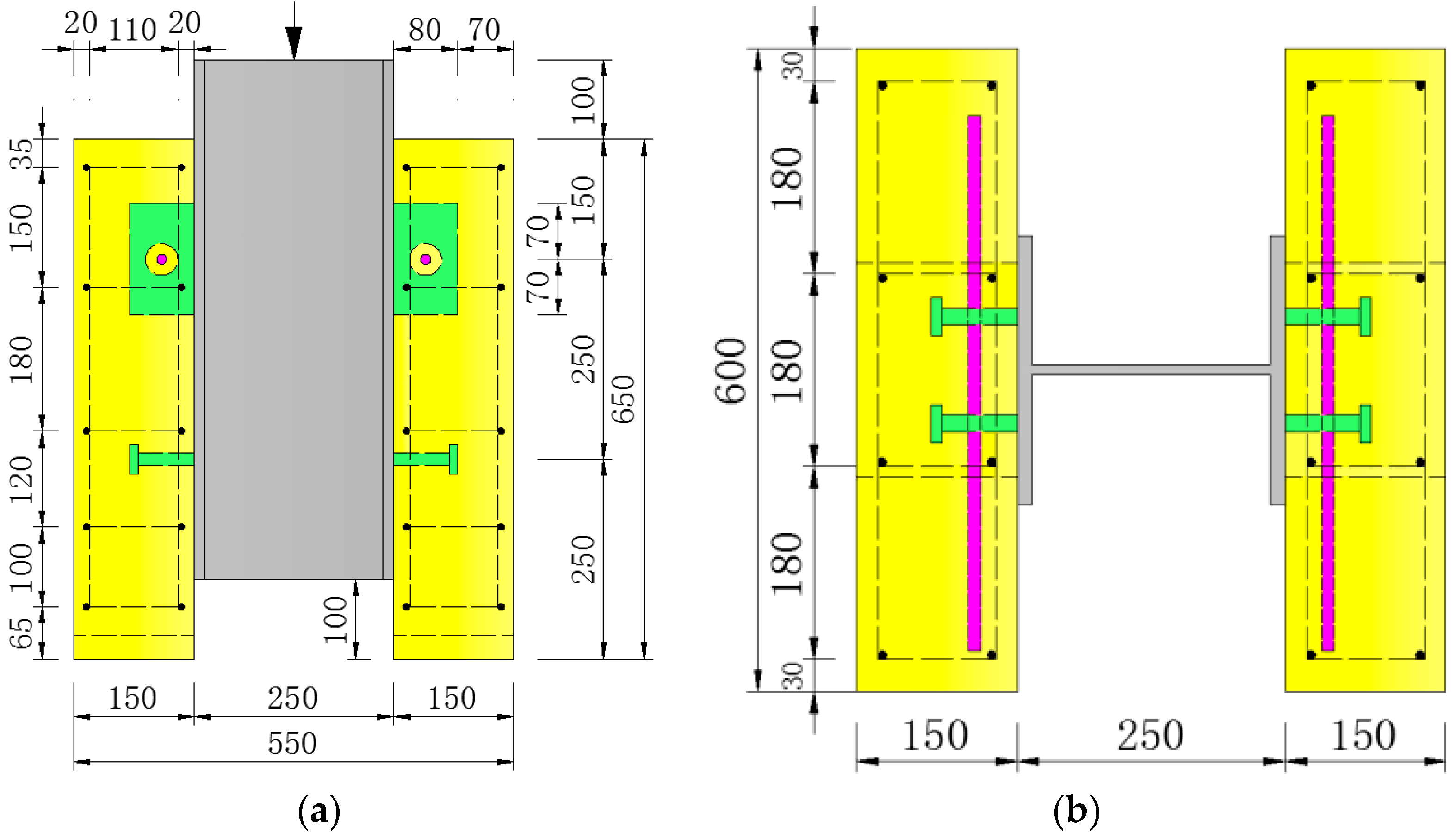
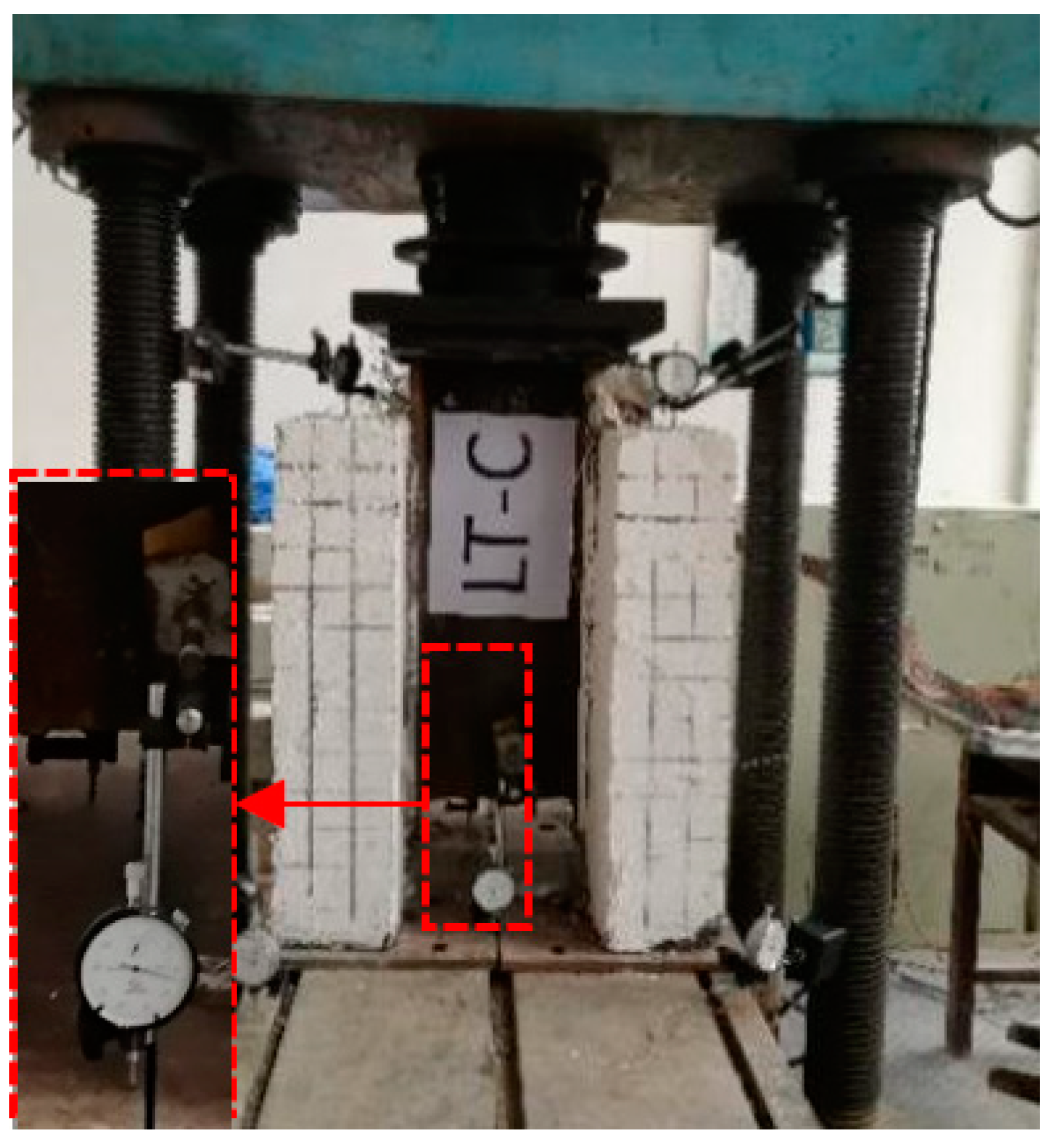
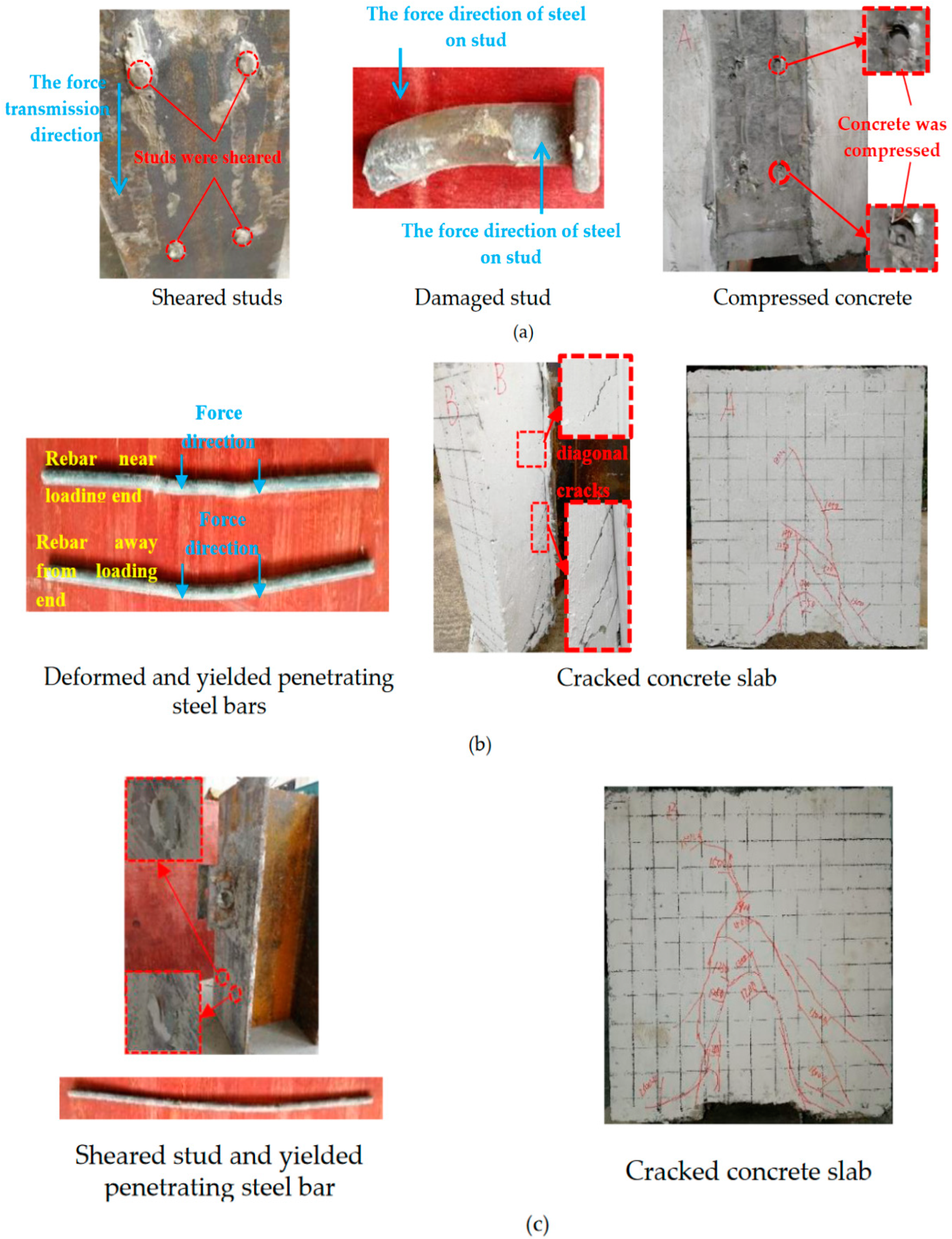
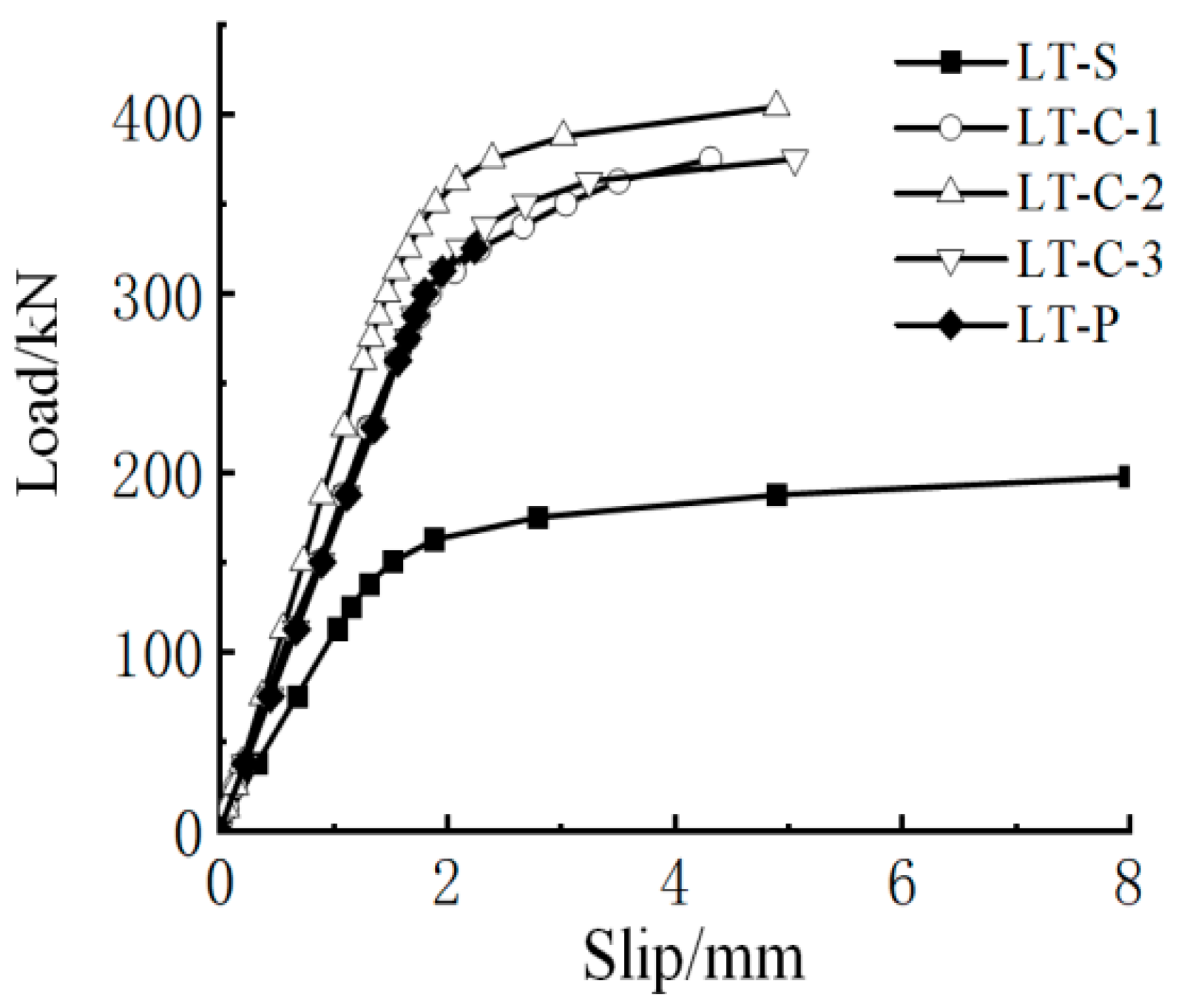
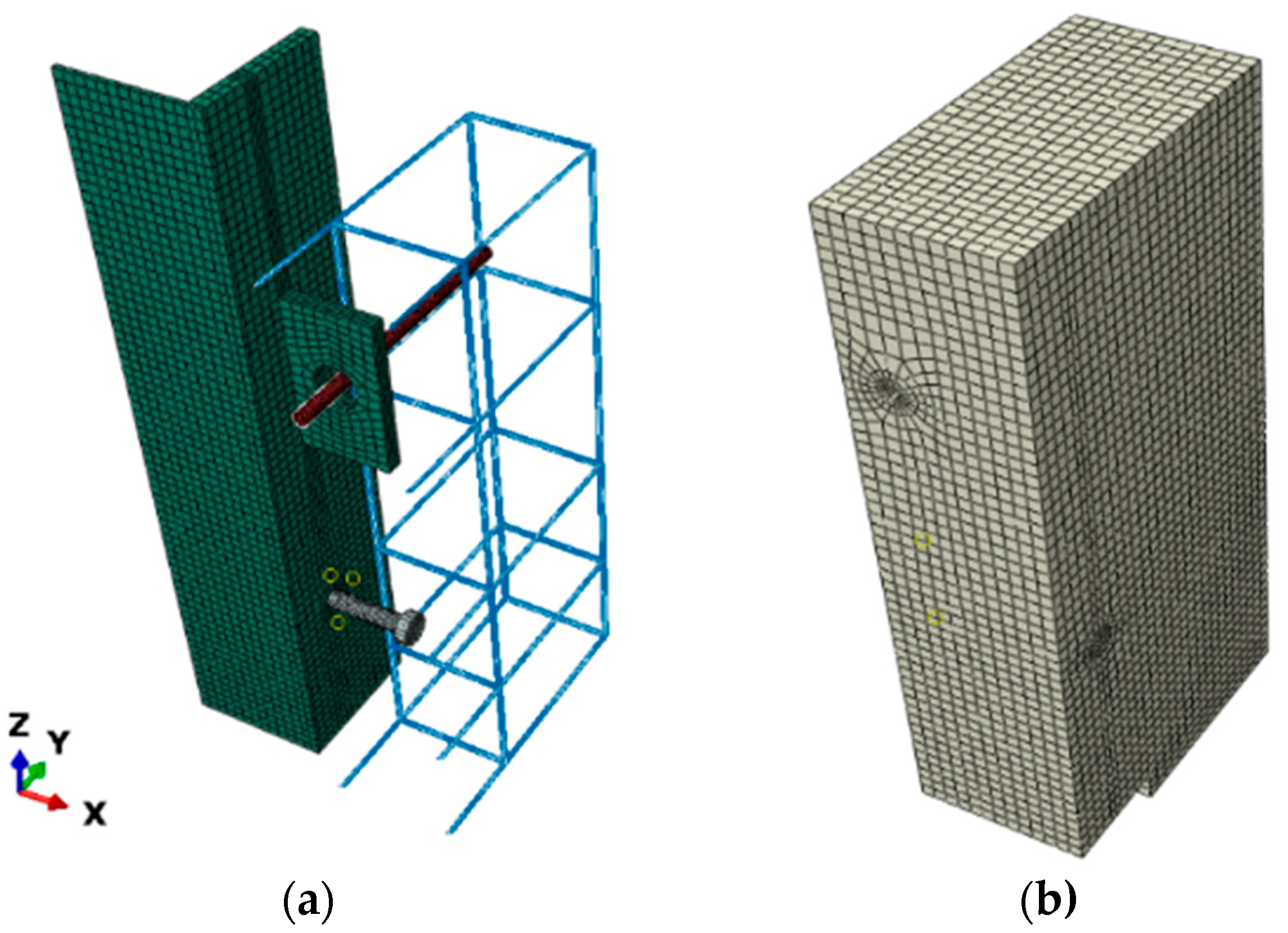

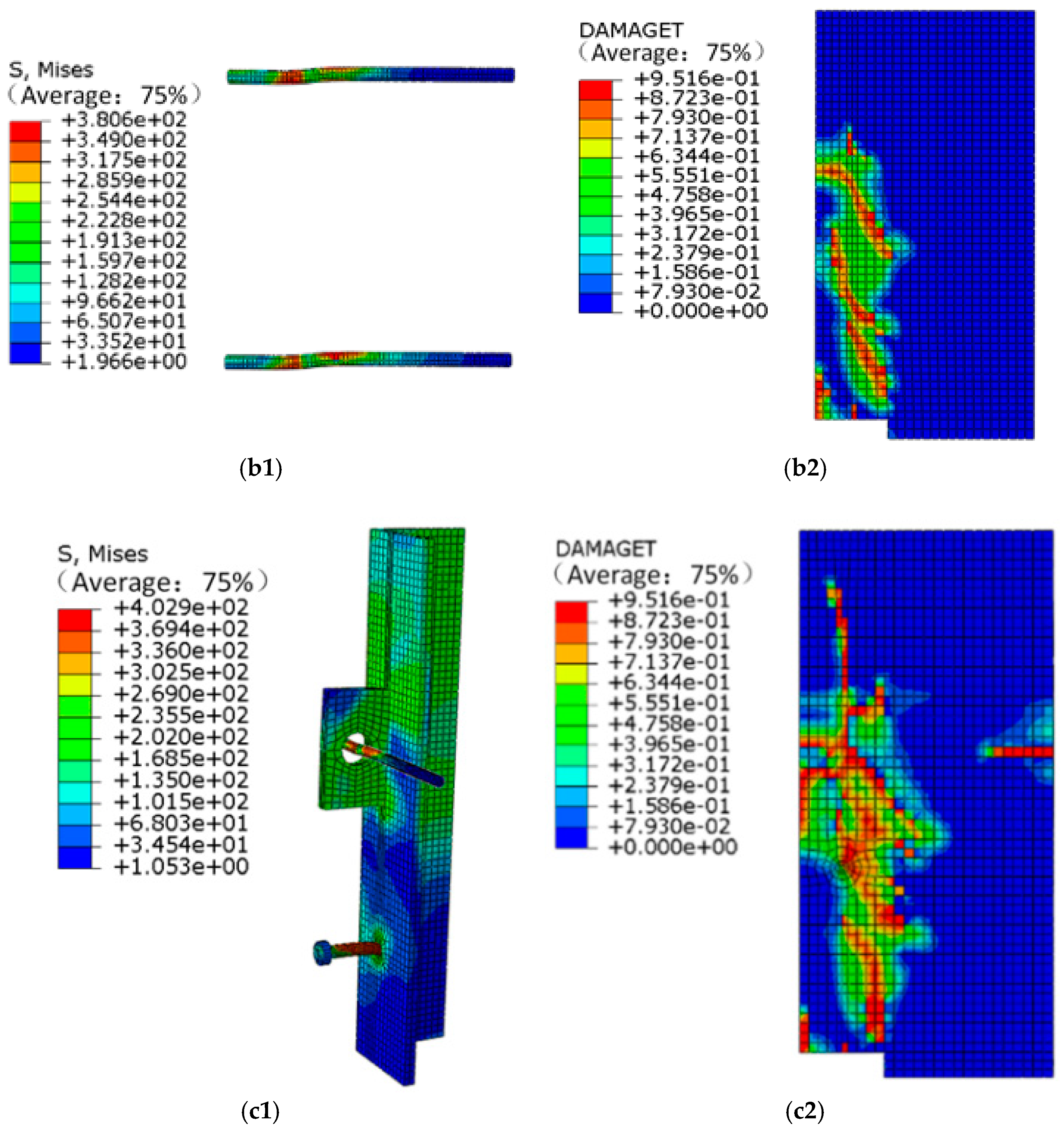
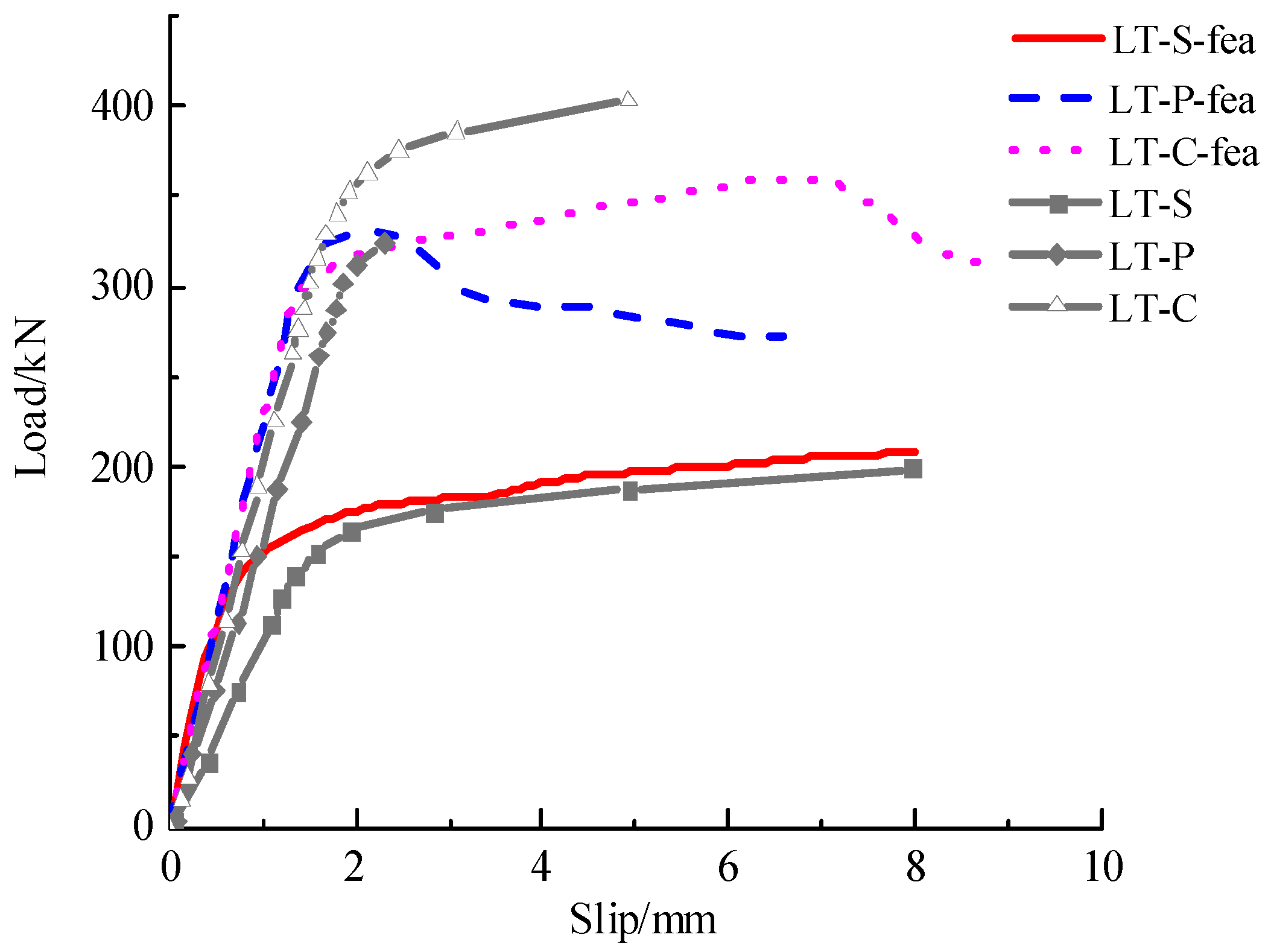


| Group | Number of Studs in a Specimen | Number of PBL Shear Connectors and Openings in a Specimen | Number of Penetrating Steel Bars in a Specimen |
|---|---|---|---|
| LT-S | 8 | - | - |
| LT-P | - | 8 | 4 |
| LT-C | 4 | 4 | 2 |
| Specimen Number | Test Value Pu/kN | Finite Element Calculation Value Pu,fea/kN | Pu,fea/Pu |
|---|---|---|---|
| LT-S | 197.3 | 207.6 | 1.05 |
| LT-P | 325.0 | 334.0 | 1.03 |
| LT-C-1 | 404.0 | 363.9 | 0.90 |
| LT-C-2 | 375.1 | 0.97 | |
| LT-C-3 | 375.1 | 0.97 | |
| LT-C Average | 384.7 | 363.9 | 0.95 |
| Group | Stud Diameter ds/mm | Opening Diameter D/mm | Perforated plate Thickness t/mm | Penetrating Steel Bar Diameter dr/mm | Concrete Cube Compressive Strength fcu/MPa | FEA Shear Bearing Capacity Values Pu,fea/kN | Equation (6) Calculated Value of Shear Bearing Capacity Pu,c/kN | Pu,c/Pu,fea |
|---|---|---|---|---|---|---|---|---|
| 1 | 13 | 30 | 16 | 12 | 40 | 287.4 | 229.31 | 0.80 |
| 50 | 327.1 | 266.63 | 0.82 | |||||
| 60 | 355.0 | 303.37 | 0.85 | |||||
| 2 | 13 | 40 | 20 | 16 | 40 | 326.2 | 289.21 | 0.89 |
| 50 | 370.2 | 336.10 | 0.91 | |||||
| 60 | 388.0 | 382.27 | 0.99 | |||||
| 3 | 13 | 50 | 24 | 20 | 40 | 345.1 | 356.92 | 1.03 |
| 50 | 384.9 | 413.77 | 1.08 | |||||
| 60 | 401.0 | 469.73 | 1.17 | |||||
| 4 | 16 | 30 | 20 | 20 | 40 | 349.9 | 324.60 | 0.93 |
| 50 | 386.6 | 370.96 | 0.96 | |||||
| 60 | 408.3 | 416.58 | 1.02 | |||||
| 5 | 16 | 40 | 24 | 12 | 40 | 339.1 | 341.59 | 1.01 |
| 50 | 380.9 | 398.39 | 1.05 | |||||
| 60 | 417.2 | 454.24 | 1.09 | |||||
| 6 | 16 | 50 | 16 | 16 | 40 | 325.2 | 307.75 | 0.95 |
| 50 | 361.4 | 350.14 | 0.97 | |||||
| 60 | 391.7 | 391.41 | 1.00 | |||||
| 7 | 19 | 30 | 24 | 16 | 40 | 349.4 | 380.04 | 1.09 |
| 50 | 399.3 | 436.70 | 1.09 | |||||
| 60 | 437.2 | 492.34 | 1.13 | |||||
| 8 | 19 | 40 | 16 | 20 | 40 | 335.7 | 345.87 | 1.03 |
| 50 | 356.3 | 387.56 | 1.09 | |||||
| 60 | 378.6 | 428.11 | 1.13 | |||||
| 9 | 19 | 50 | 20 | 12 | 40 | 339.2 | 366.93 | 1.08 |
| 50 | 375.1 | 419.54 | 1.12 | |||||
| 60 | 401.9 | 470.75 | 1.17 | |||||
| RP | 16 | 40 | 16 | 12 | 30 | 281.6 | 234.39 | 0.83 |
| 40 | 327.9 | 276.38 | 0.84 | |||||
| 52.3 | 363.9 | 326.37 | 0.90 | |||||
| 60 | 388.7 | 356.43 | 0.92 | |||||
| LT-ds13 | 13 | 40 | 16 | 12 | 40 | 300.9 | 243.55 | 0.81 |
| 52.3 | 355.9 | 291.61 | 0.82 | |||||
| 60 | 377.2 | 320.81 | 0.85 | |||||
| LT-ds19 | 19 | 40 | 16 | 12 | 40 | 335.2 | 316.01 | 0.94 |
| 52.3 | 372.9 | 368.31 | 0.99 | |||||
| 60 | 376.6 | 399.42 | 1.06 | |||||
| LT-D30 | 16 | 30 | 16 | 12 | 40 | 312.4 | 262.14 | 0.84 |
| 52.3 | 360.8 | 310.08 | 0.86 | |||||
| 60 | 354.8 | 338.99 | 0.96 | |||||
| LT-D50 | 16 | 50 | 16 | 12 | 40 | 300.3 | 294.69 | 0.98 |
| 52.3 | 351.8 | 347.30 | 0.99 | |||||
| 60 | 346.9 | 378.86 | 1.09 | |||||
| LT-t20 | 16 | 40 | 20 | 12 | 40 | 333.7 | 308.99 | 0.93 |
| 52.3 | 375.7 | 369.00 | 0.98 | |||||
| 60 | 398.0 | 405.34 | 1.02 | |||||
| LT-t24 | 16 | 40 | 24 | 12 | 52.3 | 389.4 | 411.62 | 1.06 |
| LT-dr16 | 16 | 40 | 16 | 16 | 52.3 | 363.1 | 339.10 | 0.93 |
| LT-dr20 | 16 | 40 | 16 | 20 | 52.3 | 361.8 | 355.48 | 0.98 |
| Specimen Number | j = 1 | j = 2 | j = 3 | j = 4 | FEA Shear Bearing Capacity Values Pu,fea/kN |
|---|---|---|---|---|---|
| Stud Diameter ds/mm | Opening Diameter D/mm | Perforated Plate Thickness t/mm | Penetrating Steel Bar Diameter dr/mm | ||
| 1-C50 | 13 | 30 | 16 | 12 | 327.1 |
| 2-C50 | 13 | 40 | 20 | 16 | 370.2 |
| 3-C50 | 13 | 50 | 24 | 20 | 384.9 |
| 4-C50 | 16 | 30 | 20 | 20 | 386.6 |
| 5-C50 | 16 | 40 | 24 | 12 | 380.9 |
| 6-C50 | 16 | 50 | 16 | 16 | 361.4 |
| 7-C50 | 19 | 30 | 24 | 16 | 399.3 |
| 8-C50 | 19 | 40 | 16 | 20 | 356.3 |
| 9-C50 | 19 | 50 | 20 | 12 | 375.1 |
| K1j | 1082.2 | 1113 | 1044.8 | 1083.1 | = 371.3 |
| K2j | 1128.9 | 1107.4 | 1131.9 | 1130.9 | |
| K3j | 1130.7 | 1121.4 | 1165.1 | 1127.8 | |
| κ1j | 360.7 | 371 | 348.3 | 361.0 | |
| κ2j | 376.3 | 369.1 | 377.3 | 377.0 | |
| κ3j | 376.9 | 373.8 | 388.4 | 375.9 | |
| Rj | 16.2 | 4.7 | 40.1 | 15.9 | |
| Sj | 504.0 | 33.1 | 2573.4 | 476.9 | |
| Se | / | 33.1 | / | / | |
| F | 15.2 | / | 77.7 | 14.4 |
| Specimen Number | The Test Measured Value of Shear Bearing Capacity Pu/kN | The Calculated Value of Equation (6) Pu,c/kN | Pu,c/Pu |
|---|---|---|---|
| LT-C-1 | 404.0 | 326.3 | 0.81 |
| LT-C-2 | 375.1 | 326.3 | 0.87 |
| LT-C-3 | 375.1 | 326.3 | 0.87 |
| LT-C | 384.7 | 326.3 | 0.85 |
Publisher’s Note: MDPI stays neutral with regard to jurisdictional claims in published maps and institutional affiliations. |
© 2022 by the authors. Licensee MDPI, Basel, Switzerland. This article is an open access article distributed under the terms and conditions of the Creative Commons Attribution (CC BY) license (https://creativecommons.org/licenses/by/4.0/).
Share and Cite
Zhu, H.; Fu, Z.; Liu, P.; Li, Y.; Zhao, B. Shear Behavior of Stud-PBL Composite Shear Connector for Steel–Ceramsite Concrete Composite Structure. Coatings 2022, 12, 583. https://doi.org/10.3390/coatings12050583
Zhu H, Fu Z, Liu P, Li Y, Zhao B. Shear Behavior of Stud-PBL Composite Shear Connector for Steel–Ceramsite Concrete Composite Structure. Coatings. 2022; 12(5):583. https://doi.org/10.3390/coatings12050583
Chicago/Turabian StyleZhu, Hongbing, Zhenghao Fu, Peng Liu, Yongcan Li, and Benlu Zhao. 2022. "Shear Behavior of Stud-PBL Composite Shear Connector for Steel–Ceramsite Concrete Composite Structure" Coatings 12, no. 5: 583. https://doi.org/10.3390/coatings12050583
APA StyleZhu, H., Fu, Z., Liu, P., Li, Y., & Zhao, B. (2022). Shear Behavior of Stud-PBL Composite Shear Connector for Steel–Ceramsite Concrete Composite Structure. Coatings, 12(5), 583. https://doi.org/10.3390/coatings12050583





